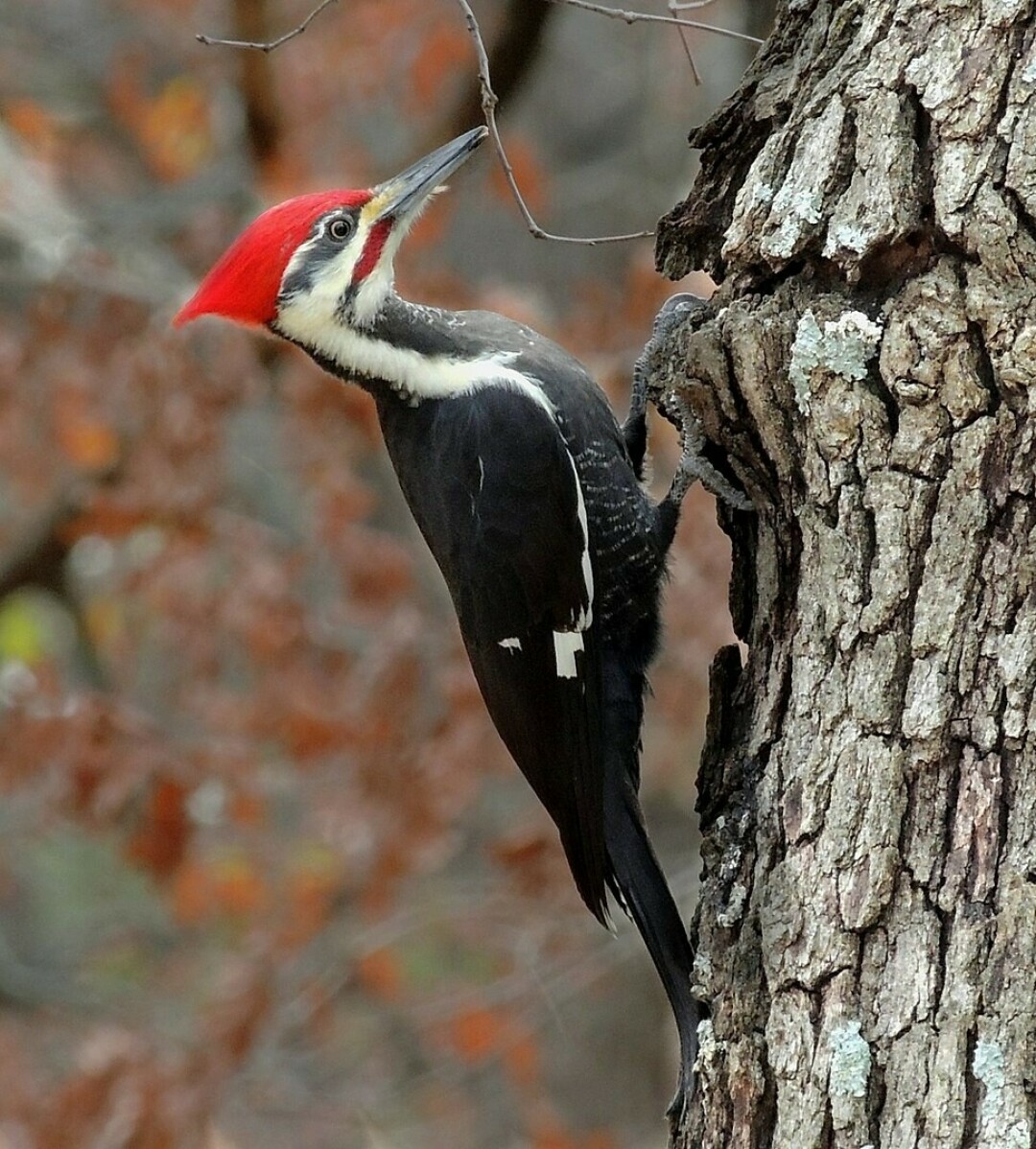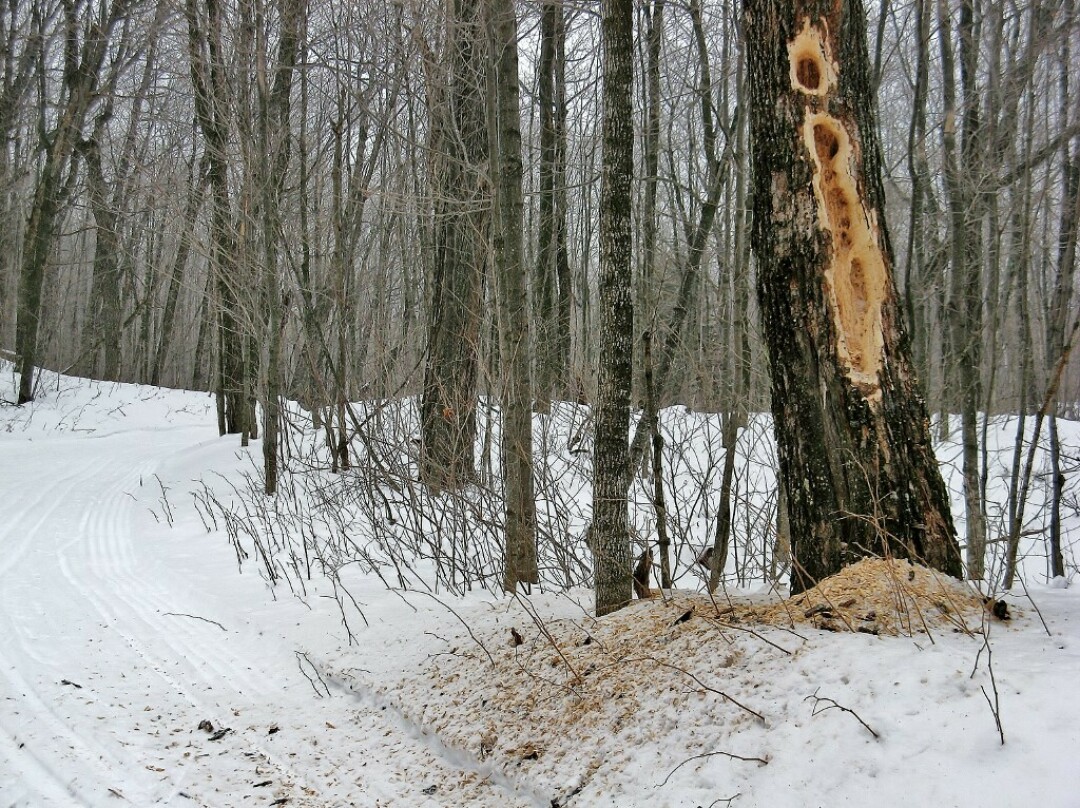News & Articles
Browse all content by date.

Male pileated woodpeckers like this one have both a red crest and a red mustache. Photo by Joshlaymon.
Conversation hummed around the office as museum staff chatted with an old friend. I couldn’t stay focused, though. Movement outside the office window had caught my eye, and it was too good to ignore.
“Hey!” I broke in. “There’s a pileated woodpecker outside the office window!”
These big, red-capped woodpeckers aren’t uncommon in the Northwoods, but it did seem a little special to have one right outside. Conversation paused and we all turned to look.
With a body length of up to 19 inches and a wingspan up to 30 inches, pileateds are the largest woodpeckers in the United States. Which is why it was a little odd that this guy was dangling almost upside down from some rather spindly boxelder twigs in a posture more suited to a chickadee. Sure, they only weigh 11 ounces, but that’s still 22x what a chickadee weighs. Twigs bent and bounced as his big bill nibbled at something.
While conversation began again, I kept watching. I could identify the woodpecker as male because in addition to his red crest, his mustache (scientists call it a malar stripe) was also scarlet. On females, this cheek stripe is black. But what was he eating?
Typically, carpenter ants and their larvae constitute anywhere from 40% to 97% of a pileated woodpecker’s diet, with beetle larvae, fruits, nuts, seeds and even poison ivy berries rounding out the rest.
None of those foods seemed logical for his current location. Golden-crowned kinglets find enough tiny caterpillars frozen onto winter twigs to fuel their 0.19 oz metabolism. Ruffed grouse get their energy from eating tree buds, but have a gizzard to grind them up and special bacteria to break down the cellulose. Boxelder seeds are toxic to horses, but have been reported as an emergency food for red squirrels. “Hey, buddy,” I wanted to shout, “What’s for lunch?”
Most of the time, we see pileated woodpeckers on big, dead trees. First, they listen for the sounds of insects moving and chewing, then they use their chisel-like beak to excavate rectangular holes, or sometimes just shred an area of punky wood. Then, they extend their barbed tongue into the hole, use it to grab a 6-legged morsel, and retract it into their mouth.

Wood chips on the snow indicate recent activity in the winter woods. Pileated woodpeckers create these rectangular holes in order to get at insects. Nest holes have a much smaller entrance. Photo by Emily Stone.
With how noisy a woodpecker’s drumming can be, I’m a little surprised that they are still able to hear such quiet sounds. I suppose there are a couple reasons for this. First, their loudest drumming is reserved for communication. When you hear their resonant tapping echoing through the forest, that’s a message to other pileateds that a pair is defending a territory. While pileated woodpeckers defend the same territory all year, they are less vocal about it in the winter.
Feeding happens every day, of course, but feeding is usually much quieter and sounds like dull thuds –if you’re even close enough to hear it.
Second, woodpeckers don’t just use their tongues to extract prey; tongues also protect their brain by wrapping around the back of the skull. A Y-shaped bone called a hyoid apparatus helps support the tongue and helps it extend –and also acts like a seatbelt for the brain.
Even the structure of their beak is important. The upper half of a woodpecker’s beak is longer, but the bone inside extends farther into the lower beak. The lower beak ends up taking more of the impact and transferring force to the body instead of the noggin.
In addition, woodpeckers have less space and fluid between their brain and their skull. While this may seem counterintuitive, it helps reduce movement of the brain during pecking – the same type of movement that gives humans a concussion in a fender bender. All of these adaptations help protect the woodpecker’s brain and hearing while they pound on trees.
It’s easy to find evidence of pileated woodpeckers feeding this time of year. Piles of wood chips accumulate under trees where pileateds are active, and even their past exploits are more visible without leaves in the understory. Weathered snags perforated by woodpecker feeding holes are always fun to see. They illustrate well the meaning of the woodpecker’s genus name Drycopus, which comes from the Greek for “tree cleaver.”
So, whether you spot a pileated dangling awkwardly from twigs or pounding away at a trunk, I hope you pause your conversation, take a moment, and admire them.
Emily Stone is Naturalist/Education Director at the Cable Natural History Museum. Her award-winning second book, Natural Connections: Dreaming of an Elfin Skimmer, is available to purchase at cablemuseum.org/books and at your local independent bookstore, too. For more than 50 years, the Cable Natural History Museum has served to connect you to the Northwoods.
Follow us on Facebook, Instagram, YouTube, and cablemuseum.org to see what we are up to.
| Tweet |

